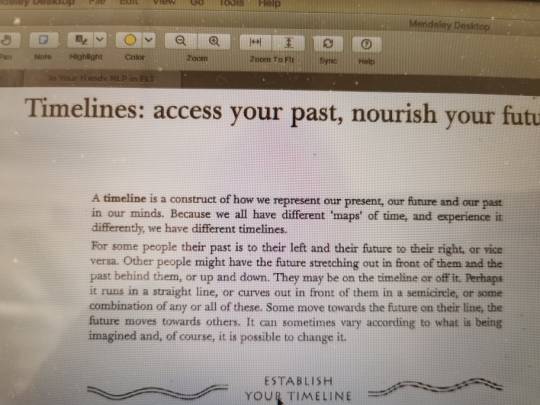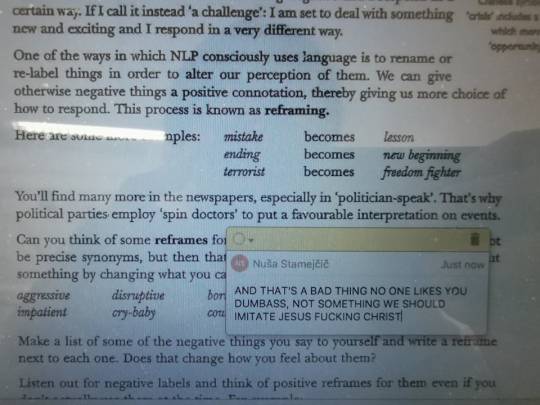#i'm sorry but using activities where the students move is WAAAAAY more benefitial
Explore tagged Tumblr posts
Note
I've never heard of this book, but since I'm studying computational linguistics NLP is right up my alley and I'd love to read you rant about it!
This will mostly be the slightly edited essay =D it’s also kinda long so follow the cut =D but first a disclaimer: i think i’m about at least 85% wrong about all of this
Okay so here’s the thing: I don’t outright hate NLP, but I don’t like its application in the classroom, especially how they described it in the book. This book was not part of my obligatory readings (it was elective obligatory, i could pick between like 5 books) and I chose this one specifically because I wanted to be proven wrong? I wanted to get why and how to use the thing in the classroom and I remain unconvinced.
So, I am a complete cynic who does not believe in any of these new-agey, crystal loving, self-actualization movements. I generally don’t even really believe in motivation: people mostly just do things because they have to and imagining we can cause an outside force that would make people genuinely interested in a tedious activity is just presumptuous. But still, motivation is at least somewhat warranted by explaining to people why they need to do something, rationalizing the activity to them, so they are more likely to do it.

But I’m deffo not a radical. I know I am probably mostly wrong about most things and too cynical about the others, so I mostly ignore my opinions. If meditation works for you, that’s great; I just don’t see the point of it for me. I am more than willing to admit I’m wrong, so I picked up this book skeptical but with a very open mind, excited to learn why and how I was wrong. After reading this book, I can tell you that my mind is now firmly closed. To put it in a metaphor (which I’ve been thinking for well over a week on how to turn it at least vaguely academic but, alas, I cannot): I am a very salt-of-the-earth Midwestern type of a person, and this book is the most LA thing I have ever read in my life (having it end with a Marianne Williamson quote is just the cherry on top of everything).
This is not to say that I don’t find anything in the book to be of any value or that I disagree with everything, not at all. What I do think is that when you read everything, the general concept of the book boils down to be a decent human to your students and acknowledge that they are individuals, not an amorphous mass. I don’t think this is too radical a claim, nor that anyone would really go against it, so I do not quite know why it requires more than one book on it. What I took away from this book is that if you see a student is helped by fidgeting, let them do that. If you see that a student takes different notes than others, but the notes seem to really work for them - let them do that. I think some rules in schools are entirely too restrictive and can be actually damaging to learning, so I think it’s time that teachers get over themselves and let students do things that help them learn. I include myself in this: for example, I hate puppets with a burning passion, but I use them with young learners because they work. So if I see that a student could be helped by this NLP method, even if I deeply and passionately hate it, I think we still should try. But, if we strive for authenticity in teaching, I do not want to lead with this method because I am truly and honestly not the person who this book tries to make me be.

Okay, with this general rant over, let me get into specifics why I did not like this book.
First of all, just the general structure is very weird. The language is very non-academic, and the book reads very much like a self-help book more than something at least vaguely academic. I have my own problems and rants about the inaccessibility and limitations of academic language and writing. However, there is still a line you have to walk to be a useful guide for teachers, and this book just doesn’t do that. The stories that are meant as lead-ins for topics break the flow entirely and usually leave you with more questions than answers.

What I hate most is the chapter titled “Changing words, changing minds” (49-50). With the caveat that my MA thesis is literally about persuasion in political discourse, so I clearly think language can be used to persuade people; this chapter is just pure and total manipulation and they mask it as SOMETHING POSITIVE. I cannot believe that it marks “reframing” (49) as something positive, which should be imitated, not something that’s actually frowned upon and what people usually mock. Language should be precise, or it should not exist. Especially in the classroom. I would rather know that my answer is wrong so I can get it right next time; than be told: “This might be the suboptimal choice.” And you have to realize that my self-confidence is not the best, and I still clearly remember every time any teacher or figure of authority told me something I said/did was wrong. Still, I would rather have that “traumatic” memories than be coddled and live, not knowing I make the same constant mistakes. Sometimes negative reinforcement works better than positive - which brings me to logical fallacies they make in this book. Mistakes are the best teachers (48), they claim, yet we cannot point to those mistakes. Language should be precise (65) but reframe every negative thought you have.

To end on a more positive note: I did like that they offered activities even though I mostly didn’t like them. That made the book less abstract and, therefore, more useful for people who can buy into the method (which again, I’m not religiously against the technique, it’s just not something I would willingly use). Most of the activities seem such that they could very easily backfire. I can just imagine the sports class I taught last year during my teaching practice laughing when you come in with a guided meditation. Any legitimate benefit it might have, immediately lost. I would just once again like to reaffirm that even though this reflection is very negative, I can see the value of the method, but it really just boils down to be kind to people and view them as individuals, and I feel like that does not require a full philosophy. I did find a copy of another book by the authors in a language school where I teach, so I might also check out that one to see if that one convinces me, because again: I do believe i’m like 85% wrong here.
#the book is on libgen go check it out#i'm sorry but using activities where the students move is WAAAAAY more benefitial#than saying to them 'don't get cold feet' instead of 'don't fear this'
1 note
·
View note